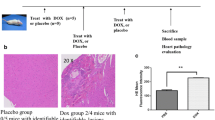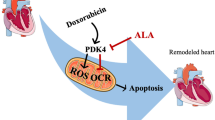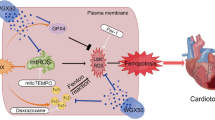Abstract
Cardiotoxicity is a major limitation for anthracycline chemotherapy although anthracyclines are potent antitumor agents. The precise mechanism underlying clinical heart failure due to anthracycline treatment is not fully understood, but is believed to be due, in part, to lipid peroxidation and the generation of free radicals by anthracycline-iron complexes. Thioredoxin (Trx) is a small redox-active antioxidant protein with potent disulfide reductase properties. Here, we present evidence that cancer cells overexpressing Trx undergo enhanced apoptosis in response to daunomycin. In contrast, cells overexpressing redox-inactive mutant Trx were not effectively killed. However, rat embryonic cardiomyocytes (H9c2 cells) overexpressing Trx were protected against daunomycin-mediated apoptosis, but H9c2 cells with decreased levels of active Trx showed enhanced apoptosis in response to daunomycin. We further demonstrate that increased level of Trx is specifically effective in anthracycline toxicity, but not with other topoisomerase II inhibitors such as etoposide. Collectively these data demonstrate that whereas high levels of Trx protect cardiomyocytes against anthracycline toxicity, it potentiates toxicity of anthracyclines in cancer cells.







Similar content being viewed by others
Data Availability
Data and reagents will be made available upon request.
References
Cardinale, D., Iacopo, F., & Cipolla, C. M. (2020). Cardiotoxicity of anthracyclines. Frontiers in Cardiovascular Medicine, 7, 26.
Bryant, J., Picot, J., Baxter, L., Levitt, G., Sullivan, I., & Clegg, A. (2007). Clinical and cost-effectiveness of cardioprotection against the toxic effects of anthracyclines given to children with cancer: A systematic review. British Journal of Cancer, 96, 226–230.
Prathumsap, N., Shinlapawittayatorn, K., Chattipakorn, S. C., & Chattipakorn, N. (2020). Effects of doxorubicin on the heart: From molecular mechanisms to intervention strategies. European Journal of Pharmacology, 866, 172818.
Hortobagyi, G. N., Bodey, G. P., Buzdar, A. U., Frye, D., Legha, S. S., Malik, R., et al. (1987). Evaluation of high-dose versus standard FAC chemotherapy for advanced breast cancer in protected environment units: A prospective randomized study. Journal of Clinical Oncology, 5, 354–364.
Coombes, R. C., Bliss, J. M., Wils, J., Morvan, F., Espie, M., Amadori, D., et al. (1996). Adjuvant cyclophosphamide, methotrexate, and fluorouracil versus fluorouracil, epirubicin, and cyclophosphamide chemotherapy in premenopausal women with axillary node-positive operable breast cancer: results of a randomized trial. The International Collaborative Cancer Group. Journal of Clinical Oncology, 14, 35–45.
DeVita, V. T., Jr., & Hubbard, S. M. (1993). Hodgkin's disease. New England Journal of Medicine, 328, 560–565.
Long, T. M., Marsh, C. E., Dembo, L. G., Watson, P., Wallman, K. E., Walwyn, T. S., et al. (2019). Early markers of cardiovascular injury in childhood leukaemia survivors treated with anthracycline chemotherapy. Cardiooncology, 5, 11.
Bottinor, W. J., Soslow, J. H., Godown, J., Stoddard, M. F., Osmundson, E. C., Lenneman, C. G., et al. (2020). Childhood cancer survivors: The integral role of the cardiologist and cardiovascular imaging. American Heart Journal, 226, 127–139.
Elliott, P. (2006). Pathogenesis of cardiotoxicity induced by anthracyclines. Seminars in Oncology, 33, S2–7.
Singal, P. K., & Iliskovic, N. (1998). Doxorubicin-induced cardiomyopathy. New England Journal of Medicine, 339, 900–905.
Curry, H. L., Parkes, S. E., Powell, J. E., & Mann, J. R. (2006). Caring for survivors of childhood cancers: the size of the problem. European Journal of Cancer, 42, 501–508.
Holmgren, A. (1985). Thioredoxin. Annual Review of Biochemistry, 54, 237–271.
Holmgren, A., & Bjornstedt, M. (1995). Thioredoxin and thioredoxin reductase. Methods in Enzymology, 252, 199–208.
Mitsui, A., Hirakawa, T., & Yodoi, J. (1992). Reactive oxygen-reducing and protein-refolding activities of adult T cell leukemia-derived factor/human thioredoxin. Biochemical and Biophysical Research Communications, 186, 1220–1226.
Das, K. C., & Das, C. K. (2000). Thioredoxin, a singlet oxygen quencher and hydroxyl radical scavenger: redox independent functions. Biochemical and Biophysical Research Communications, 277, 443–447.
Powis, G., & Montfort, W. R. (2001). Properties and biological activities of thioredoxins. Annual Review of Biophysics and Biomolecular Structure, 30, 421–455.
Das, K. C., Lewis-Molock, Y., & White, C. W. (1997). Elevation of manganese superoxide dismutase gene expression by thioredoxin. American Journal of Respiratory Cell and Molecular Biology, 17, 713–726.
Rubartelli, A., Bajetto, A., Allavena, G., Wollman, E., & Sitia, R. (1992). Secretion of thioredoxin by normal and neoplastic cells through a leaderless secretory pathway. Journal of Biological Chemistry, 267, 24161–24164.
Ravi, D., & Das, K. C. (2004). Redox-cycling of anthracyclines by thioredoxin system: increased superoxide generation and DNA damage. Cancer Chemotherapy and Pharmacology, 54, 449–458.
Ravi, D., Muniyappa, H., & Das, K. C. (2005). Endogenous thioredoxin is required for redox cycling of anthracyclines and p53-dependent apoptosis in cancer cells. Journal of Biological Chemistry, 280, 40084–40096.
Shinkai, Y., Iwamoto, N., Miura, T., Ishii, T., Cho, A. K., & Kumagai, Y. (2012). Redox cycling of 1,2-naphthoquinone by thioredoxin1 through Cys32 and Cys35 causes inhibition of its catalytic activity and activation of ASK1/p38 signaling. Chemical Research in Toxicology, 25, 1222–1230.
Das, K. C. (2001). c-Jun NH2-terminal kinase-mediated redox-dependent degradation of IkappaB: Role of thioredoxin in NF-kappaB activation. Journal of Biological Chemistry, 276, 4662–4670.
Muniyappa, H., Song, S., Mathews, C. K., & Das, K. C. (2009). Reactive oxygen species-independent oxidation of thioredoxin in hypoxia: Inactivation of ribonucleotide reductase and redox-mediated checkpoint control. Journal of Biological Chemistry, 284, 17069–17081.
Plummer, E. R. (2006). Inhibition of poly(ADP-ribose) polymerase in cancer. Current Opinion in Pharmacology, 6, 364–368.
Soldani, C., & Scovassi, A. I. (2002). Poly(ADP-ribose) polymerase-1 cleavage during apoptosis: An update. Apoptosis, 7, 321–328.
Myers, C. (1998). The role of iron in doxorubicin-induced cardiomyopathy. Seminars in Oncology, 25, 10–14.
Levitt, G. A., Dorup, I., Sorensen, K., & Sullivan, I. (2004). Does anthracycline administration by infusion in children affect late cardiotoxicity? British Journal of Haematology, 124, 463–468.
Batist, G., Ramakrishnan, G., Rao, C. S., Chandrasekharan, A., Gutheil, J., Guthrie, T., et al. (2001). Reduced cardiotoxicity and preserved antitumor efficacy of liposome-encapsulated doxorubicin and cyclophosphamide compared with conventional doxorubicin and cyclophosphamide in a randomized, multicenter trial of metastatic breast cancer. Journal of Clinical Oncology, 19, 1444–1454.
Hellmann, K. (1996). Cardioprotection by dexrazoxane (Cardioxane; ICRF 187): progress in supportive care. Supportive Care in Cancer, 4, 305–307.
Shioji, K., Kishimoto, C., Nakamura, H., Masutani, H., Yuan, Z., Oka, S., et al. (2002). Overexpression of thioredoxin-1 in transgenic mice attenuates adriamycin-induced cardiotoxicity. Circulation, 106, 1403–1409.
Yokomizo, A., Ono, M., Nanri, H., Makino, Y., Ohga, T., Wada, M., et al. (1995). Cellular levels of thioredoxin associated with drug sensitivity to cisplatin, mitomycin C, doxorubicin, and etoposide. Cancer Research, 55, 4293–4296.
Wang, J., Kobayashi, M., Sakurada, K., Imamura, M., Moriuchi, T., & Hosokawa, M. (1997). Possible roles of an adult T-cell leukemia (ATL)-derived factor/thioredoxin in the drug resistance of ATL to adriamycin. Blood, 89, 2480–2487.
Berggren, M. I., Husbeck, B., Samulitis, B., Baker, A. F., Gallegos, A., & Powis, G. (2001). Thioredoxin peroxidase-1 (peroxiredoxin-1) is increased in thioredoxin- 1 transfected cells and results in enhanced protection against apoptosis caused by hydrogen peroxide but not by other agents including dexamethasone, etoposide, and doxorubicin. Archives of Biochemistry and Biophysics, 392, 103–109.
Ma, X., Karra, S., Lindner, D. J., Hu, J., Reddy, S. P., Kimchi, A., et al. (2001). Thioredoxin participates in a cell death pathway induced by interferon and retinoid combination. Oncogene, 20, 3703–3715.
Ueda, S., Nakamura, H., Masutani, H., Sasada, T., Yonehara, S., Takabayashi, A., et al. (1998). Redox regulation of caspase-3(-like) protease activity: regulatory roles of thioredoxin and cytochrome c. The Journal of Immunology, 161, 6689–6695.
Kundumani-Sridharan, V., Subramani, J., & Das, K. C. (2015). Thioredoxin activates MKK4-NFkappaB pathway in a redox dependent manner to control manganese superoxide dismutase gene expression in endothelial cells. Journal of Biological Chemistry, 290, 17505–17509. https://doi.org/10.1074/jbc.M115.660365.
Funding
The study was funded by National Institutes of Health Grant Number HL107885, HL109397, HL132953.
Author information
Authors and Affiliations
Contributions
KD conceptualized the idea, designed the study, wrote manuscript, performed experiments; HM performed experiments; VK-S performed experiments; JS performed experiments.
Corresponding author
Ethics declarations
Conflict of interest
All authors declare that they have no conflicts of interest.
Additional information
Handling editor: Vittorio Fineschi.
Publisher's Note
Springer Nature remains neutral with regard to jurisdictional claims in published maps and institutional affiliations.
Rights and permissions
About this article
Cite this article
Das, K.C., Muniyappa, H., Kundumani-Sridharan, V. et al. Thioredoxin Decreases Anthracycline Cardiotoxicity, But Sensitizes Cancer Cell Apoptosis. Cardiovasc Toxicol 21, 142–151 (2021). https://doi.org/10.1007/s12012-020-09605-2
Received:
Accepted:
Published:
Issue Date:
DOI: https://doi.org/10.1007/s12012-020-09605-2




